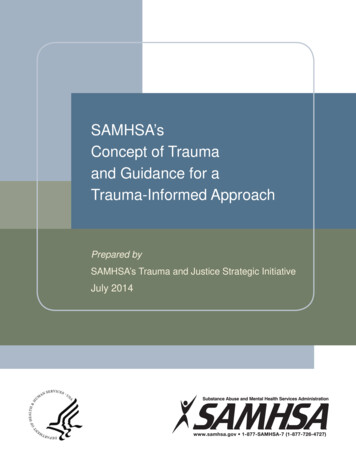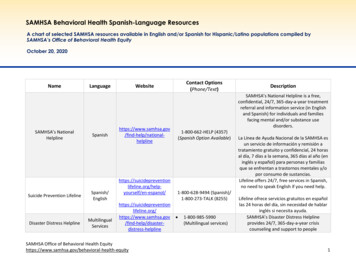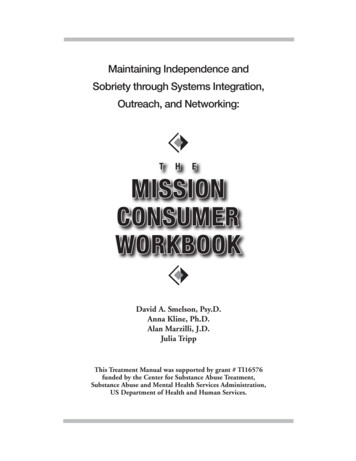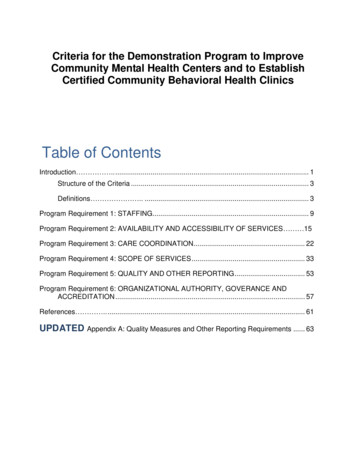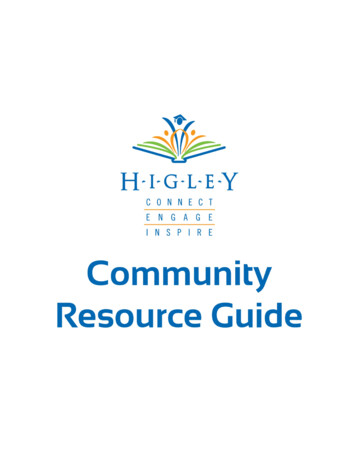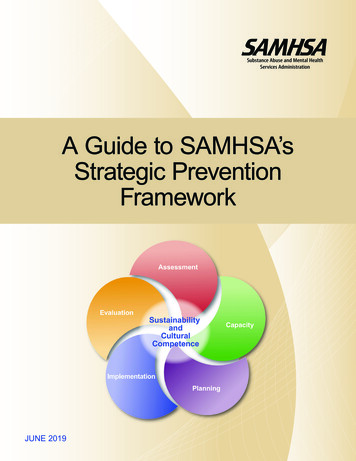
Transcription
A Guide to SAMHSA’sStrategic PreventionFrameworkJUNE 2019
AcknowledgmentsThe content of this report was developed by SAMHSA staff. The final report was formated for the SubstanceAbuse and Mental Health Services Administration (SAMHSA) under contract number HHSS283176901with SAMHSA, U.S. Department of Health and Human Services (HHS). Claudia Richards served ascontracting officer representative.DisclaimerThe views, opinions, and content of this publication are those of the authors and do not necessarily reflect theviews, opinions, or policies of SAMHSA or HHS. Nothing in this document constitutes a direct or indirectendorsement by SAMHSA or HHS of any non-Federal entity’s products, services, or policies, and anyreference to non-Federal entity’s products, services, or policies should not be construed as such.Public Domain NoticeAll material appearing in this publication is in the public domain and may be reproduced or copiedwithout permission from SAMHSA. Citation of the source is appreciated. However, this publicationmay not be reproduced or distributed for a fee without the specific, written authorization of the Office ofCommunications, SAMHSA, HHS.Electronic AccessThis publication may be downloaded from nded CitationSubstance Abuse and Mental Health Services Administration: A Guide to SAMHSA's Strategic PreventionFramework. Rockville, MD: Center for Substance Abuse Prevention. Substance Abuse and Mental HealthServices Administration, 2019.Originating OfficeCenter for Substance Abuse Prevention, Substance Abuse and Mental Health Services Administration, 5600Fishers Lane, Rockville, MD 20857, HHS PublicationNondiscrimination NoticeSAMHSA complies with applicable Federal civil rights laws and does not discriminate on the basis of race,color, national origin, age, disability, or sex.SAMHSA cumple con las leyes federales de derechos civiles aplicables y no discrimina por motivos de raza,color, nacionalidad, edad.
TABLE OF CONTENTSIntroduction . . . . . . . . . . . . . . . . . . . . . . . . . . . . . . . . . . . . . . . . . . . . . . . . . . . . . . . . . . . . . . . . . 4Step 1: Assessment . . . . . . . . . . . . . . . . . . . . . . . . . . . . . . . . . . . . . . . . . . . . . . . . . . . . . . . . . . . 6Step 2: Capacity . . . . . . . . . . . . . . . . . . . . . . . . . . . . . . . . . . . . . . . . . . . . . . . . . . . . . . . . . . . . 11Step 3: Planning . . . . . . . . . . . . . . . . . . . . . . . . . . . . . . . . . . . . . . . . . . . . . . . . . . . . . . . . . . . . 14Step 4: Implementation . . . . . . . . . . . . . . . . . . . . . . . . . . . . . . . . . . . . . . . . . . . . . . . . . . . . . . . 20Step 5: Evaluation . . . . . . . . . . . . . . . . . . . . . . . . . . . . . . . . . . . . . . . . . . . . . . . . . . . . . . . . . . . 23SPF Guiding Principle: Cultural Competence . . . . . . . . . . . . . . . . . . . . . . . . . . . . . . . . . . . . . 26SPF Guiding Principle: Sustainability . . . . . . . . . . . . . . . . . . . . . . . . . . . . . . . . . . . . . . . . . . . . 29APPENDICES . . . . . . . . . . . . . . . . . . . . . . . . . . . . . . . . . . . . . . . . . . . . . . . . . . . . . . . . . . . . . . 32Appendix A: Primary Data Collection Methods . . . . . . . . . . . . . . . . . . . . . . . . . . . . . . . . . . 33Appendix B: Key Features of Risk and Protective Factors . . . . . . . . . . . . . . . . . . . . . . . . . 36Appendix C: Levels of Involvement . . . . . . . . . . . . . . . . . . . . . . . . . . . . . . . . . . . . . . . . . . . 38Appendix D: The Socio-Ecological Model . . . . . . . . . . . . . . . . . . . . . . . . . . . . . . . . . . . . . . 39Appendix E: Making the Most of Your Evaluation Dollars . . . . . . . . . . . . . . . . . . . . . . . . . . 41Appendix F: Evaluation Design, Reporting, and Lessons Learned . . . . . . . . . . . . . . . . . . . 433
INTRODUCTIONPrevention planners are pressed to put in place solutions to urgentsubstance misuse problems facing their communities. But researchand experience have shown that prevention must begin with anunderstanding of these complex behavioral health problems within theircomplex environmental contexts; only then can communities establishand implement effective plans to address substance misuse.To facilitate this understanding, SAMHSA developed the StrategicPrevention Framework (SPF). The five steps and two guiding principlesof the SPF offer prevention planners a comprehensive approach tounderstanding and addressing the substance misuse and relatedbehavioral health problems facing their states and communities.The SPF includes these five steps:1 . Assessment: Identify local prevention needs based on data (e .g ., What is the problem?)2 . Capacity: Build local resources and readiness to address prevention needs (e .g ., What do youhave to work with?)3 . Planning: Find out what works to address prevention needs and how to do it well (e .g ., Whatshould you do and how should you do it?)4 . Implementation: Deliver evidence-based programs and practices as intended (e .g ., How canyou put your plan into action?)5 . Evaluation: Examine the process and outcomes of programs and practices (e .g ., Is your plansucceeding?)The SPF is also guided by two cross-cutting principles that should be integrated into each of the stepsthat comprise it: Cultural competence. The ability of an individual or organization to understand andinteract effectively with people who have different values, lifestyles, and traditions based on theirdistinctive heritage and social relationships. Sustainability. The process of building an adaptive and effective system that achieves andmaintains desired long-term results.A GUIDE TO SAMHSA’S STRATEGIC PREVENTION FRAMEWORK4
The SPF has several defining characteristics that set it apart from other strategic planning processes.Most notably, it is: Dynamic and iterative. Assessment is the starting point, but planners will return to thisstep again and again as their community’s substance misuse problems and capacities evolve.Communities may also engage in activities related to multiple steps simultaneously. For example,planners may need to find and mobilize additional capacity to support implementation once aprogram or practice is underway. For these reasons, the SPF is a circular rather than a linearmodel. Data-driven. The SPF is designed to help planners gather and use data to guide all preventiondecisions—from identifying which substance misuse problems to address in their communities,to choosing the most appropriate ways to address these problems, to determining whethercommunities are making progress. Reliant on and encourages a team approach. Each step of the SPF requires—andgreatly benefits from—the participation of diverse community partners. The individuals andinstitutions involved in prevention efforts may change as the initiative evolves, but the need forprevention partners will remain constant.This toolkit provides an introduction to the SPF’s well-tested and user-friendly planning approach.Organized by each of the steps in the framework, the toolkit provides a snapshot of how each ofthe components fit together and build on one another. Used in tandem with its companion resource,Selecting Best-Fit Programs and Practices: Guidance for Substance Misuse Prevention Practitioners, thetoolkit provides an important starting point for engaging in a thoughtful, data-driven process that supportsbest practices, engages critical stakeholders, and draws on evidence. Adherence to the principles inthe framework increases the likelihood that prevention efforts will produce anticipated outcomes, reduceharmful behaviors, and keep communities healthy and safe.5
STEP 1: ASSESSMENTOVERVIEWThe purpose of this step is to understand local prevention needs based on a careful review of datagathered from a variety of sources. These data help planners to identify and prioritize the substancemisuse problems present in their community; clarify the impact these problems have on communitymembers; identify the specific factors that contribute to these problems; assess readiness; anddetermine the resources required to address those factors. Ultimately, a thorough and inclusiveassessment process helps to ensure that substance misuse prevention efforts are appropriate andon target.To conduct a comprehensive assessment of prevention needs, prevention professionals gather dataabout each of the following: The nature of the substance misuse problem in the community and related harmful behaviors Risk and protective factors that influence substance misuse problems, particularly those of highpriority in the community Community capacity for prevention, including readiness and available resourcesStep 1:AssessmentAssessproblems andrelatedbehaviorsPrioritize problems(criteria: magnitude,time trend, severity,comparison)Assess riskandprotectivefactorsStep 2:RELATED BEHAVIORSPROBLEMS ANDCapacityRaiseand misuse problemsIt is important to assess the natureEngageand extent of bothDevelopsubstanceand related harmfulcommunitystrengthen acommunitybehaviors in the community. But stakeholderswhat are problemspreventionand whatare behaviors?awarenessteamSubstance misuse problems are characterized by the behavior patterns that describe how substancesare misused, for example, binge drinking alcohol. In turn, substance misuse problems may lead to otherharmful behaviors or adverse outcomes, such as traffic accidents and fatalities from driving under theSelect between substanceinfluence of alcoholHowever,and otherDevelopmisuseaStepor3:other drugs.Prioritizerisk the relationshipinterventionscomprehensivePlanningand protectiveassociated problemsis not one-to-one.An individual’ssubstance misuse behavior can lead to a wide(criteria:plan that alignsfactors(criteria:effectiveness,range of problems, often multiple ones—including illnesses,injuries, violencetotheself and others, andwithimportance,conceptualfit,modelcrimes. For example, binge drinkingamong 12- to 17-year-olds can lead tologicalcoholpoisoning, motorchangeability)practical fit)vehicle crashes, delinquent and violent acts, and other serious problems reported in this age group.ASSESSING PROBLEMS AND RELATED HARMFUL BEHAVIORSPrevention plannersStepcan4: use the following questions to guide community assessment of substanceBalance fidelityDeliverEstablishImplementationRetain coremisuse problemsand related harmfulbehaviors: with plannedprograms ports andmonitorA GUIDE TO SAMHSA’S STRATEGIC PREVENTION FRAMEWORK6
What substance misuse problems (e.g., overdoses, alcohol poisoning) and related harmfulbehaviors (e.g., prescription drug misuse, underage drinking) are occurring in the community? How often are these substance misuse problems and related harmful behaviors occurring?Which ones are happening the most? Where are these substance misuse problems and related harmful behaviors occurring(e.g., at home or in vacant lots, in small groups or during big parties)? Who is experiencing more of these substance misuse problems and related harmful behaviors(e.g., males, females, youth, adults, members of certain cultural groups)?The answers to these questions can help planners identify—and determine how to most effectivelyaddress—a community’s priority substance misuse problem(s). To obtain these answers, plannersrely on data. Data is the driving force behind the SPF planning process. Prevention efforts are moresuccessful when planners use data to understand the substance misuse problems facing theircommunities.Community practitioners and planners may begin by collecting existing state and local archival data thatare readily available. In some instances, states, tribes, and jurisdictions have established epidemiologicalworkgroups—collaborative groups of agencies and individuals focused on using data to inform andenhance prevention practice at both the state and local levels. These workgroups collect, analyze,and disseminate a wide variety of substance use and behavioral health data. These findings areoften presented in epidemiological profiles—detailed reports that summarize the problems affecting aparticular community or population. Hospitals, law enforcement agencies, community organizations, andstate agencies can also be important sources of data.Once the data are compiled, it is important to examine and discard what is irrelevant or not useful.It is also important to determine whether any information (e.g., about a particular problem, behavior,or population group) is missing and, if so, identify ways to fill data gaps by collecting new data. (SeeAppendix A to learn about data collection methods and their benefits and limitations.)PRIORITIZING PROBLEMS AND RELATED HARMFUL BEHAVIORSData collected through the assessment process may reveal that a community has multiple areas ofneed that are contributing to substance misuse. Planners will want to establish criteria for analyzingassessment data in order to determine how to prioritize problem(s). These criteria may include thefollowing: Magnitude: Describes the prevalence of a specific substance misuse problem or harmfulbehavior (e.g., Which problem/behavior is most widespread in your community?) Severity: Describes how large an impact a specific substance misuse problem or harmfulbehavior has on the people or the community (e.g., Which problem/harmful behavior ismost serious?) Trend: Describes how substance misuse patterns are changing over time within a community(e.g., Which problem/harmful behavior is getting worse or better?)7
Changeability: Describes how likely it is that a community will be able to modify the problemor behavior (e.g., Which problem/harmful behavior are you most likely to influence with yourprevention efforts?)When setting priorities, planners should consider all four of these criteria together in order to gain abalanced view of the problem, its significance in the community, and the potential for change. Differentplanners or practitioners may weigh each criterion differently, depending on their unique communitycontext and perspective. Working through these considerations is important to build support for thecommunity prevention efforts that will be directed to the priority substance misuse problem.ASSESSING RISK AND PROTECTIVE FACTORSOnce a community has identified one or more priority problems, it is important to look at the factorsassociated with those problems. Two types of factors influence the likelihood that an individual willdevelop a substance misuse or related mental health problem: Risk factors are associated with a higher likelihood of developing a problem (e.g., low impulsecontrol, peer substance use). Protective factors are associated with a lower likelihood of developing a problem (e.g., academicachievement, parental bonding, and family cohesion).Understanding risk and protective factors is essential to prevention.Problemsand relatedbehaviorsRisk andprotectivefactorsProgramsandpracticesPrevention planners cannot change a substance misuse problem directly. Instead, they need to workthrough the underlying risk and protective factors that influence the problem. A prevention program orpractice can only make a difference if it’s a good match for both the problem and its underlying factors.The following are some key features of risk and protective factors: Risk and protective factors exist in multiple contexts (e.g., individual, family, peer, and community).Risk and protective factors are correlated and cumulative.Individual factors can be associated with multiple problems.Risk and protective factors are influential over time.It is important to recognize that the underlying factors driving a substance misuse problem in onecommunity may differ from the factors driving that same problem in a different community. Effectiveprevention focuses on reducing the risk factors and strengthening the protective factors specific to thepriority problem in your community. (See Appendix B to learn more about risk and protective factors.)A GUIDE TO SAMHSA’S STRATEGIC PREVENTION FRAMEWORK8
ASSESSING CAPACITY FOR PREVENTIONAssessing a community’s available resources and readiness to address substance misuse is a key partof the prevention planning process. Prevention efforts are more likely to succeed when they are informedby a complete assessment of a community’s capacity to address the identified substance misuseproblems. Capacity for prevention includes two main components: resources and readiness.Resources include anything a community can use to establish and maintain a prevention effort thatcan respond effectively to local problems. Examples include: People (e.g., staff, volunteers)Specialized knowledge and skills (e.g., research expertise)Community connections (e.g., access to population groups)Concrete supplies (e.g., money, equipment, technology)Community awareness about local substance misuse problems (e.g., high rates of opioidoverdose) Existing efforts to address those problems (e.g., policies)A well-planned and focused resource assessment will produce far more valuable information than onethat casts a wide net. To that end, it’s helpful to focus capacity assessments on resources that arerelated to your priority problem(s). At the same time, keep in mind that useful and accessible resourcesmay also exist beyond the boundaries of the community’s substance misuse prevention effort. Manyorganizations, including state and government agencies, law enforcement, health care centers, andfaith-based organizations are also working to reduce the impact of substance misuse and other harmfulbehavioral health problems.Readiness describes the motivation and willingness of a community to commit local resources toaddressing identified substance misuse problems. Factors that affect readiness include: Knowledge of the substance misuse problemExisting efforts to address the problemAvailability of local resourcesSupport of local leadersCommunity attitudes toward the problemReadiness assessments should reflect the preparedness of the community sectors that will be involvedin addressing the priority problem and/or will be affected by it. To do this, prevention planners mustengage in a culturally competent assessment process that includes representatives from acrosscommunity sectors. A thorough capacity assessment should include information about: 9The cultural and ethnic makeup of the communityHow problems are perceived among different sectors of the communityWho has been engaged in previous prevention effortsExisting barriers to participation in prevention efforts
To assess readiness for prevention, it is often helpful to speak, one-on-one, with local decision-makersand public opinion leaders. If individuals with access to critical prevention resources are not initiallysupportive of or invested in prevention efforts, then it will be important to find ways early on to increasetheir level of readiness.Understanding local capacity, including both resources and readiness, helps prevention planners to: Make realistic decisions about which substance misuse problem(s) a community is prepared toaddress. Identify resources a community may need, but doesn’t currently have, for addressing identifiedprevention needs. Develop a clear plan for building and mobilizing capacity (see SPF Step 2) to address identifiedproblems.Assessing community readiness, in particular, helps prevention professionals determine whether thereis social momentum for addressing the issue(s) they hope to tackle. Community readiness is just asimportant in addressing substance misuse problems as having tangible resources in place.SHARING ASSESSMENT FINDINGSThe final step in completing a needs and capacity assessment is to communicate key findings toprevention stakeholders. There are many ways to share findings, but what is critical is that the chosenapproach is the right match for the audience. Included below are some key considerations for sharingassessment findings. Develop a full report. Funders and close prevention partners (e.g., task force members) will wantthe whole story. It’s helpful to have all of the details in one place. Highlight key findings. For stakeholders who may be interested only in assessment highlights,develop brief handouts or short slide presentations. One size does not fit all. Be prepared to tailor assessment materials by featuring those data thatare most meaningful to each audience. This is particularly important when presenting assessmentfindings to key stakeholders (e.g., local decision-makers, public opinion leaders, and potentialpartners). If these individuals have specific questions or reservations, be sure to address them. Solicit input from the community. Find ways for community members and groups to providefeedback on the assessment results. Their comments can help to confirm that prevention plansare on track and/or shed light on findings that may have been confusing or surprising.A GUIDE TO SAMHSA’S STRATEGIC PREVENTION FRAMEWORK10
STEP 2: CAPACITYOVERVIEWIn this step, local resources are built and mobilized and the community’s readiness to address prioritysubstance misuse problems is determined. In Step 1, planners took stock of what was available in theircommunities. In Step 2, they ensure the readiness of the community to buy in to the prevention effort andtake stock of the resources needed to tackle the problem and produce a positive change.A community needs both human and structural resources to establish and maintain a prevention systemthat can respond effectively to local problems. It also needs people who have the motivation andwillingness—that is, the readiness—to commit local resources to addressing these problems.The following are three strategies for building local capacity for prevention:1. Engage diverse community stakeholders2. Develop and strengthen a prevention teamStep 1:3. Raise community awarenessAssessabout the issue Prioritize problemsAssess riskandproblems and(criteria: magnitude,protectiverelatedtimetrend,severity,By building and mobilizing local capacity for prevention, planners create the foundationcommunities willfactorsbehaviorscomparison)Assessmentneed to begin developing prevention efforts that will be effective and enduring.Step 2:CapacityEngagecommunitystakeholdersDevelop andstrengthen aprevention teamRaisecommunityawarenessSelectDevelop ainterventionscomprehensive(criteria:plan that alignsfactors (criteria:effectiveness,Substance misuse is a complex behavioraland to address it withrequiresthe the energy,importance,health problem,conceptual fit,logicmodelexpertise, and experience of revention plannerschangeability)practical fit)Step 3:Prioritize riskENGAGING DIVERSEPlanning STAKEHOLDERSand protectiveneed diverse partners—from neighborhood residents to service providers to community leaders—to share information and resources, raise awareness about critical substance misuse problems,build support for prevention, and ensure that prevention activities reach multiple populations withmultiple strategies in multiple settings. By involving community members in all aspects of preventionStep 4:Balance fidelity respect for the people they serveplanning, implementation,and evaluation,EstablishDeliver planners demonstrateImplementationRetain corewith plannedimplementationprogramsandcomponentsand are more likely to develop prevention services thatmeet genuine needs,build on strengths, andadaptationssupports andpracticesproduce positive outcomes.monitorStep 5:Evaluation11ConductprocessevaluationA GUIDE TO SAMHSA’S STRATEGIC PREVENTION entsand makemid-coursecorrectionsShare andreportevaluationresults
Following are community sectors that planners may want to involve in prevention efforts: Treatment providersLaw enforcementHealth care providersLocal governmentYouth-serving agencies and institutions Local businessesUniversity and research institutionsNeighborhood and cultural associationsFaith communitiesIt is important to build relationships with stakeholders who support prevention efforts as well as withthose who do not. It is also important to recognize that potential community partners will have varyinglevels of interest and/or availability to get involved. One person may be willing to help out with a specifictask, while another may be willing to assume a leadership role. Keep in mind that as people cometo understand the importance of prevention efforts, they are likely to become more engaged. (SeeAppendix C to learn more about levels of involvement.)The following list includes some of the ways to approach people and organizations in the community withinformation about, and invitations to participate in, prevention efforts: Call known contacts, particularly those with overlapping interestsAttend and speak up at community meetings and eventsAsk partners to contact their partnersKeep potential partners well informed about prevention activities and progress madeMeet with key players, including public opinion leaders and local decision-makersAnticipate and overcome roadblocks (e.g., address the concerns of those who might oppose orhinder prevention efforts)Included below are different ways to encourage stakeholders who are already engaged to get moreinvolved in prevention efforts: Meet face-to-face to discuss overlapping goals and agendasExtend an invitation to attend a prevention team or task force meetingOnce prevention planning is underway, make more specific requests for involvementExtend invitations to attend future prevention events and activitiesMaintain relationships by keeping stakeholders informed of prevention activities and progressmadeDEVELOPING AND STRENGTHENING A PREVENTION TEAMA strong prevention team is often the guiding force behind effective prevention efforts. The preventionteam, or task force, should include representatives from those community sectors that are most vitalto the success of the prevention initiative. In other words, the prevention team will be a subset ofthe stakeholders identified above. Here are some considerations for building and/or strengthening aprevention team: Be deliberate. Establishing a representative prevention team requires deliberate and strategicplanning. When inviting new members, be clear about the purpose of the collaboration, determinehow goals will be attained, and establish clear roles and responsibilities for all involved.A GUIDE TO SAMHSA’S STRATEGIC PREVENTION FRAMEWORK12
Build prevention knowledge. A truly representative prevention team means that members willbring diverse insights and experiences to the table, as well as varied knowledge and perspectiveson the priority problem being addressed. Use a variety of strategies—including guest speakersand group trainings—to increase the team’s understanding of the problem and effective preventionstrategies. Monitor and improve group structure and processes, as needed. Even the most well-informed group won’t be productive unless it functions well. To help the team work togethereffectively, discuss how you will share leadership, make decisions, divide tasks, resolve conflicts,and communicate with one another as well as with the broader community.RAISING COMMUNITY AWARENESSBy raising public awareness about a community’s priority substance misuse problem(s), preventionplanners can help garner valuable resources and increase local readiness for prevention. The followingare some strategies for raising community awareness: Meet one-on-one with public opinion leadersAsk task force members to share information in their own sectorsSubmit articles to local newspapers, church bulletins, neighborhood newsletters, etc.Share information on relevant websites and social media outletsHost community events to share information about and discuss the problemConvene focus groups to get input on prevention plansIt is always helpful to think “outside the box” when looking for new ways to raise community awareness.For example, the local high school may have a media club that can help to create a video about thecommunity’s priority problem and/or prevention efforts. Also, think about “ripple” potential—that is,which individuals and community groups might help to spread the word and get others involved inprevention efforts.Finally, when building capacity, don’t forget about the data. Data collected during the assessmentprocess can help to increase general awareness about critical prevention problems and engage keystakeholders. Data can also be used to mobilize resources to support prevention efforts.13
STEP 3: PLANNINGOVERVIEWStrategic planning increases the effectiveness of prevention efforts by ensuring that prevention plannersselect and implementthe1:most appropriate programs and strategies for their communities. In an effectiveStepAssess ng process,Assessmentcommunities involvediverse stakeholders,and hunches with dataandproblems and(criteria: magnitude,driven decisions, and create comprehensive,plansprotectiv
Jun 20, 2019 · Prevention Framework (SPF) . The five steps and two guiding principles of the SPF offer prevention planners a comprehensive approach to understanding and addressing the substance misuse and related behavioral health problems facing their states and communities
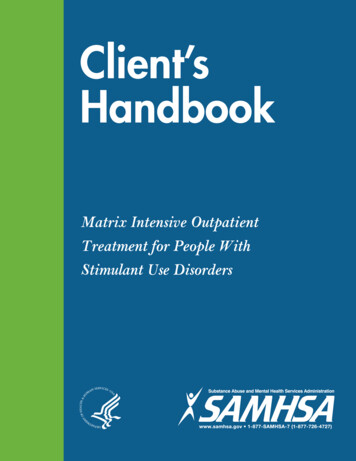
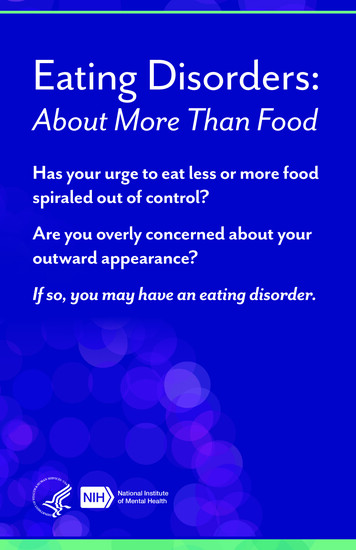
![[NAME OF STATE] - SAMHSA](/img/8/state-certification-guide.jpg)
